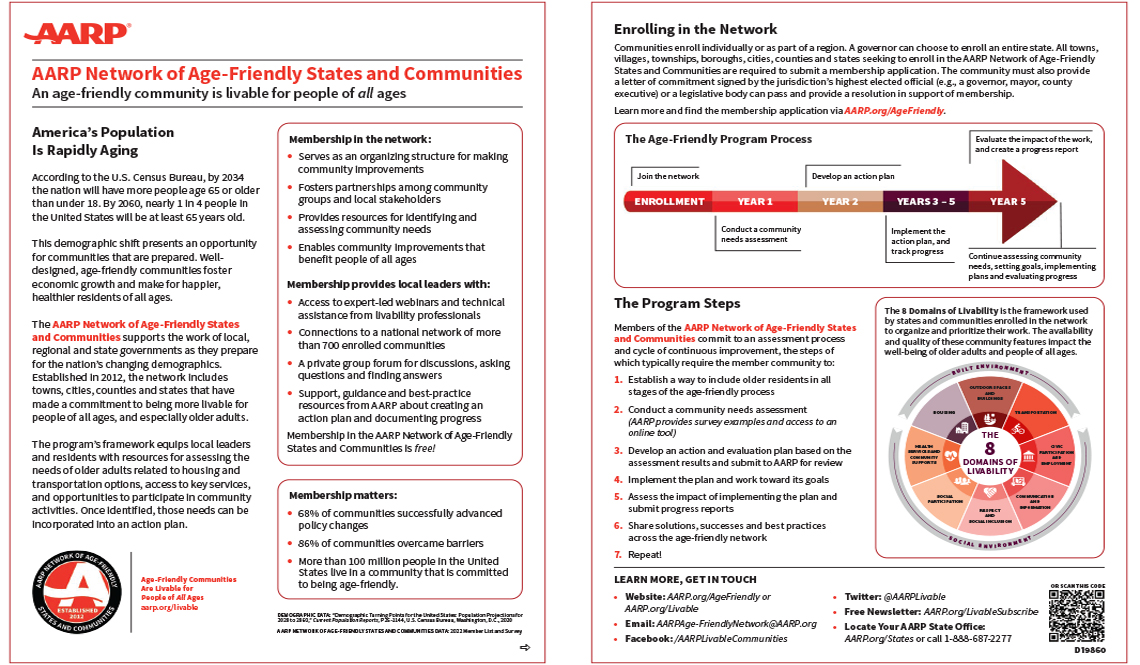Introducing the Age-Friendly Network
An age-friendly community is livable for people of all ages
The AARP Network of Age-Friendly States and Communities serves as a catalyst to educate local leaders (both elected officials and engaged residents) and encourage them to implement the types of changes that make communities more livable for people of all ages, especially older adults.
The network provides cities, towns, counties and states with the resources to become more age-friendly by tapping into national and global research, planning models and best practices.
Membership in the AARP Network of Age-Friendly States and Communities means that a community’s elected leadership has made a commitment to actively work with residents and local advocates to make their town, city, county or state an age-friendly place to live.
A community’s age-friendly leaders and champions will likely include:
- Elected officials
- Government agencies
- Nonprofit organizations and foundations
- Academic institutions
- Area Agencies on Aging
- Community coalitions
- Local businesses
- Chambers of Commerce
- Residents and lots of volunteers
Joining the Network
There is no fee to join the AARP Network of Age-Friendly States and Communities. Communities enroll individually, as part of a region or as a state.*
All towns, villages, townships, boroughs, cities, counties and states seeking to enroll in the AARP age-friendly network are required to submit a membership application.
In addition, the community must provide a letter of commitment signed by the jurisdiction’s highest elected official (e.g. a governor, mayor, county executive).
Communities with council or commission forms of government typically pass a resolution in support of membership in the network.
The Survey Says
After enrolling in the network:
60% of member communities achieved a change in public policy, most often by integrating an “age-friendly lens” into community planning
34% achieved a private-sector investment or action — such as by local retailers and restaurants securing “age-friendly business” designations, commitments by builders to expand their use of age-friendly design standards, and partnerships with taxi services to provide discounted rides to older adults
85% described other successes, such as raising awareness about livability issues, increasing collaborations within the community, and implementing educational and engagement programs
Check out The Member List
* Survey distributed to members of the AARP Network of Age-Friendly States and Communities (February 2019)
Membership in the network:
- Helps local leaders identify and understand community needs
- Serves as an organizing structure for making community improvements
- Fosters partnerships among community groups and local stakeholders
- Provides leadership opportunities for volunteers
- Enables changes that benefit people of all ages
Membership provides a community with:
- Public recognition for committing to becoming age-friendly
- Resources for identifying and assessing community needs
- Access to technical assistance and expert-led webinars
- Support and best practice materials from AARP
What Membership Isn't
- Communities in the AARP age-friendly network are not retirement villages, gated developments, nursing homes or assisted living facilities. Nor are they planned communities or age-restricted housing developments.
- Membership in the network does not mean that the community is, currently, "age-friendly" or a great place to retire.
- Membership in the network does not mean AARP endorses the towns, cities, counties or states as places to live.
* State enrollment in the network does not confer automatic membership on that state’s local communities.
Background
The AARP Network of Age-Friendly States and Communities is the United States affiliate of the World Health Organization Global Network for Age-Friendly Cities and Communities, an international effort launched in 2006 to help cities prepare for rapid population aging and the parallel trend of urbanization.
AARP's participation in the program advances efforts to help people live easily and comfortably in their homes and communities as they age. AARP’s presence encourages older adults to take a more active role in their communities and have their voices heard. Initiatives focus on areas such as housing, caregiving, community engagement, volunteering, social inclusion and combating isolation among older citizens.
AARP works with local officials and partner organizations around the country to identify communities for membership in the age-friendly network. AARP facilitates the community's enrollment and guides its representatives through the network’s implementation and assessment process.
Combined with the resources provided by AARP — either through AARP.org/Livable (this website) or the AARP Public Policy Institute — the AARP Network of Age-Friendly States and Communities program supports AARP's goal of being recognized by elected officials and others as a leading resource for how to improve the livability of communities for people age 50 or older and their families.
The program emphasizes both the built and the social environment, and helps refine what it means for AARP to have a community presence. The AARP Network of Age-Friendly States and Communities program is a tool that can be used by AARP staff and others to help local leaders prepare and ultimately change their communities to become great places for everyone to live.
Page updated September 2023
Stay Informed — For Free!
AARP.org/Livable
Enter a topic, name, place, etc.




